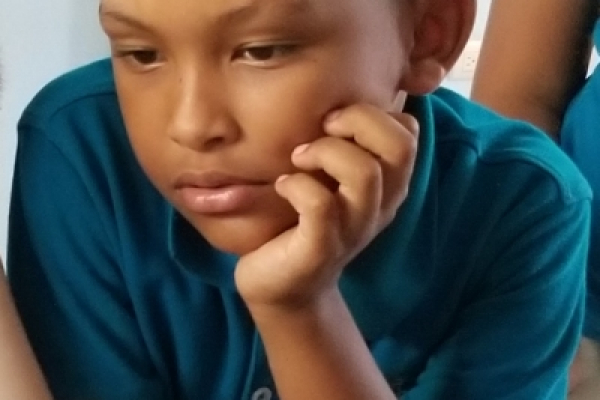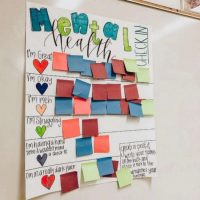Supporting Students through First Day Jitters

– First Day Jitters by Julie Dannenberg[1]
First Day Jitters is a favorite classroom book for many elementary teachers to read on the first day of school to their students. It is all about a girl named Sarah who doesn’t want to go to school. Later in the story the reader may be surprised to find out that Sarah Jane Hartwell is actually the teacher! It is a fun story to read to students to begin a conversation about nerves and the first day of school. First day jitters are not just for students, teachers get them to. What a better way to ease students concerns than to be able to relate to them in this way.
Do you remember the feeling on Christmas Eve as a child? Do you remember how excited you were? Do you remember the night before a big exam or an important sports game? Maybe as an adult you remember the night before your first interview or even first day of your job? These are all big events in our lives and big events can bring big emotions- both happy feelings and worried or sad ones.
As teachers and school staff we may be nervous, excited, anxious, worried, surprised, and so many other emotions on the first day of school. As adults, we generally have more capacity to process our emotions about starting school. Our life experiences help us to remember that even through nervousness things will be ‘ok.’
Our students may be walking in nervous, excited, or somewhere in between. They are coming from many different circumstances, experiences, and backgrounds. Walking our students through any transition is an important part of teachers’ and school staff’s responsibilities. How do we do that well?
PRAY
First, and most importantly, pray! Pray for your students! Pray for their hearts as they prepare for the first day of school and any emotions they may be feeling. Cover your students’ minds in prayer as they prepare to learn and hear about their ‘new’ classroom, grade level, teacher, classmates, and for some, school. Pray for wisdom and discernment as you support your students well. As you pray, ask the Lord for patience, love, and compassion for your students. As you begin the year, pray with your students as well. Model giving the Lord our emotions and concerns. Cover every aspect in prayer!
Start Each Day with a Check In
Start each day or class period with a personal connection. It doesn’t have to be a fancy or long  procedure. Sometimes this is as simple as giving a warm greeting with a smile or asking the students a question. A simple check in to see ‘where students are’ can be a quick thumbs up, thumbs to the side, thumbs down or a show of fingers: 1 being I am feeling upset, sad, or worried and 5 being I am doing super fantastic. You could also use a variety of printable or more detailed written check ins where students reflect on their emotions.
procedure. Sometimes this is as simple as giving a warm greeting with a smile or asking the students a question. A simple check in to see ‘where students are’ can be a quick thumbs up, thumbs to the side, thumbs down or a show of fingers: 1 being I am feeling upset, sad, or worried and 5 being I am doing super fantastic. You could also use a variety of printable or more detailed written check ins where students reflect on their emotions.
Use Read Alouds or Storytime
Read alouds are an amazing tool for exploring social-emotional themes with your class. There are even many picture books with more complex themes and vocabulary that older kids will love. Picture books are great for many reasons. They give students the opportunity to relate to characters. Through books, students can build their social-emotional vocabulary and put words to their thoughts and feelings.
Read alouds are also a favorite because they present opportunities for more natural discussion. In our story First Day Jitters I might ask students early on, Why is Sarah worried? Later in the story I may pause and ask students to reflect on their own emotions about the first day. By the end of the story I would have stopped and challenged students to think, share, and discuss multiple times. It gives you as a teacher a glimpse into students minds, especially those that may otherwise be afraid to share. And, yes, read alouds work for secondary students as well.
Here are a couple of resources for books:
Have fun, Slow Down, and Be Flexible!
Have fun with your students. Play games and be intentional about opportunities to build relationships with your students. The more you build trust and rapport, you will be able to support them emotionally.
Slow down, take the time to listen to your students and be willing to be flexible. Sometimes objectives, a to do list, or even lesson plans can be our focus in the classroom. Really, we need to be in-tune to the needs of our students to support them emotionally. Lesson plans are important, but if your students aren’t in the mindset to learn emotionally you won’t be able to truly ‘get through to them.’
Teachers, school staff, and parents – you’ve got this! Be confident in the ability the Lord has given you to support your students all around.
Lindsey Estes
Associate Regional Director
TeachBeyond, Africa Region
[1] Danneberg, J. (2000). First day jitters. Charlesbridge.
Photo Credits:
Thoughtful Student. E. Burnham. Resized.
Mental Health Check-In. Erin Castillo via Instagram/makingastatementinsped. Resized.
